Franchise Corner Entry: SAW
SAW **** Australia 2003 Dir: James Wan. 9 mins.
This dynamic short film represents a filmed excerpt from a script by James Wan and Leigh Whannell designed to attract film studios in the pursuit of funding for the feature length version. By the end of 2004, the full-length SAW had enjoyed acclaim at the Sundance Film Festival and a highly lucrative worldwide theatrical release, initiating a franchise that generated six sequels in six years, scores of imitators and a 2017 revival named JIGSAW.
A punchy, intense calling card for director Wan, the story is relayed in flashback by hospital orderly David (Whannell), who is abducted while finishing his shift and wakes up with a reverse bear trap fixed to his face. The sinister puppet that would soon become world famous appears on a TV set while an ominous voice introduces key catchphrases of the franchise’s master villain: “I want to play a game” / “Live or die, make your choice…” David’s only chance of survival from the imminently triggered trap is to retrieve a key from the stomach of an apparently dead man in the same room. In the kind of cruel twist typical of the films that followed, the guy is merely paralysed but, driven by survival instinct, David fulfils the action suggested by his mysterious abductor.
Set to a jarring industrial score and sustaining an amped-up sense of dread via restless, circling camera work, jump cuts and hyperkinetic editing, it’s easy to see why this proved so attractive to Lions Gate, though no one could have predicted the long-running saga that followed.
SAW ***** USA 2004 Dir: James Wan. 103 mins
As pivotal a movie for the burgeoning Lions Gate Films as A NIGHTMARE ON ELM STREET was for New Line Cinema, the big-screen debut for ambitious Aussie filmmakers Wan and Whannell offers a ruthless, visceral variation on SE7EN. The concept revolves around the similarly ingenious film-long game-plan of a sadistically brilliant madman who, having crafted a series of gruesomely contrived death-traps for deserving / sinning “victims”, proves the victor in the protracted cat and mouse game he plays with our heroes. A direct parallel between that film’s all-purpose misanthrope John Doe and cancer-stricken John Kramer aka “Jigsaw” (played with malevolent yet low key relish by one-time 24 villain Tobin Bell, and mostly heard rather than seen) is that Jigsaw doesn’t conventionally “kill” his victims – he places them in lethal scenarios from which very few could possibly survive. The signature moment in the original SAW – and hugely influential to the franchise’s evolution – involves drug addict Shawnee Smith surviving a reverse bear trap that will rip her jaw apart unless she retrieves a key from a living man’s stomach. She survives but the outcome is less certain for the two chained men in a derelict bathroom: adulterous surgeon Cary Elwes and private detective Whannell, who are forced to follow gruelling instructions or else face a terrible fate.
Also setting the tone for the sequels, SAW employs an intricate, flashback-driven structure reminiscent of THE USUAL SUSPECTS, which helps rejuvenate some of the more cliched elements of the story – including a sub plot featuring Danny Glover (himself deconstructing his familiar cuddly screen cop persona) as an obsessive cop trailing Jigsaw for killing his partner. The disorientating approach felt fresh for a typically linear sub-genre, keeping the audience on edge and also cannily masking the final twist. Reflecting the unforgiving tone of much American horror in the early 2000’s, the mood is relentlessly downbeat: the camera lingers on shots of shitty toilets and exposed intestines, culminates with a scene of Elwes sawing off his own foot and offers jarring scenes of psychological terror – notably the scene in which Jigsaw puts a gun to a kid’s head just to enjoy hearing her heartbeat faster.
Wan wears his influences on his sleeve, with direct visual homages to DEEP RED’s creepy doll and BLACK CHRISTMAS’ staring eye, alongside witty scene transitions, fashionable fast-cuts, circling camerawork and an appropriately dour industrial score by Nine Inch Nails’ Danny Lohner and Charlie Clouser. As with SE7EN (but unlike all the sequels that were to follow), the nastiest stuff is suggested rather than shown, and the overt suspense set pieces (Whannell’s flashbulb-lit encounter in a darkroom with Jigsaw) are highly charged. The post-Shyamalan twist ending reinforces the nihilistic world view, pivoting around a clever reversal of a cliché (the shifty-looking orderly) and ingenious misdirection involving a reviving “corpse” that reworks the key bathroom scene in LES DIABOLIQUES. As a pair of deliberately unsympathetic, doomed protagonists descending into hysteria, Whannell and Elwes deliver uneven performances, but are the only real weak links in this black-hearted benchmark of post-9/11 U.S. genre cinema.
SAW II **** USA / Canada 2005 Dir: Darren Lynn Bousman. 93 mins
Rushed into production following the surprise worldwide success of SAW – as with every sequel until SAW: THE FINAL CHAPTER, it was released a year after its predecessor – this worthy successor (co-written by Leigh Whannell) reworks the grim ambience, gimmicky plotting and circular twist ending to impressive effect. Amping up the visceral content compared to the relatively restrained SAW, it opens with a distillation of its main, sadistic appeal: a police informant is locked in a room with a Venus fly-trap device fastened to his head. It will slam shut unless he retrieves a key within 60 seconds – a key he needs to extract from behind his eyeball. Following this harrowing, gut-punch prologue, dirty cop Donnie Wahlberg is distracted from his fucked-up marriage and evidence-planting daily routine by Jigsaw’s ambitious new “game” : he has locked eight people (including Wahlberg’s son and sole Jigsaw survivor Shawnee Smith) in a brutal variation on the Big Brother house, crafting riddles, traps and clues that lead to suffering and death. As he reveals a two-hour interval before the release of a nerve gas that will cause them all to bleed from every orifice, Jigsaw provides the movie with its memorable tagline, gloating “Oh yes, there will be blood…”
Pale, gaunt and voice rarely rising above a whisper, Bell is a formidable presence in SAW II, an omnipresent and sympathetic puppet-master of an unfolding massacre as the imprisoned strangers fall victim to selfishness, curiosity and sheer panic. In the film’s cleverest touch, Jigsaw is captured at the start of this sequel but in command the whole time (a la John Doe in SE7EN), offering hints to Wahlberg that would save lives if the cop wasn’t too hot-headed and stupid to figure them out. The violence is suitably harsh, with a bullet-through-the-keyhole gag stolen from Argento’s OPERA, an icky bout of self-mutilation and a non-bloody but hard-to-watch sequence in which Smith falls into a pit of used hypodermic needles. Reaffirming SAW franchise trademarks, all the characters deserve what’s coming to them, the backdrop is suitably grotty and decayed and the marvellous twist pulls the rug from under the viewer’s eyes via a not-a-live-feed reveal (recycled for JIGSAW) and a revelation of the true intentions of “heroine” Smith, securing her relevance in the next chapter. SAW II also establishes, rather cleverly, that this will be a rare horror franchise dedicated to continuity, complete with appropriately rotting representations of the ill-fated protagonists of SAW.
SAW III **** USA 2006 Dir: Darren Lynn Bousman. 108 mins
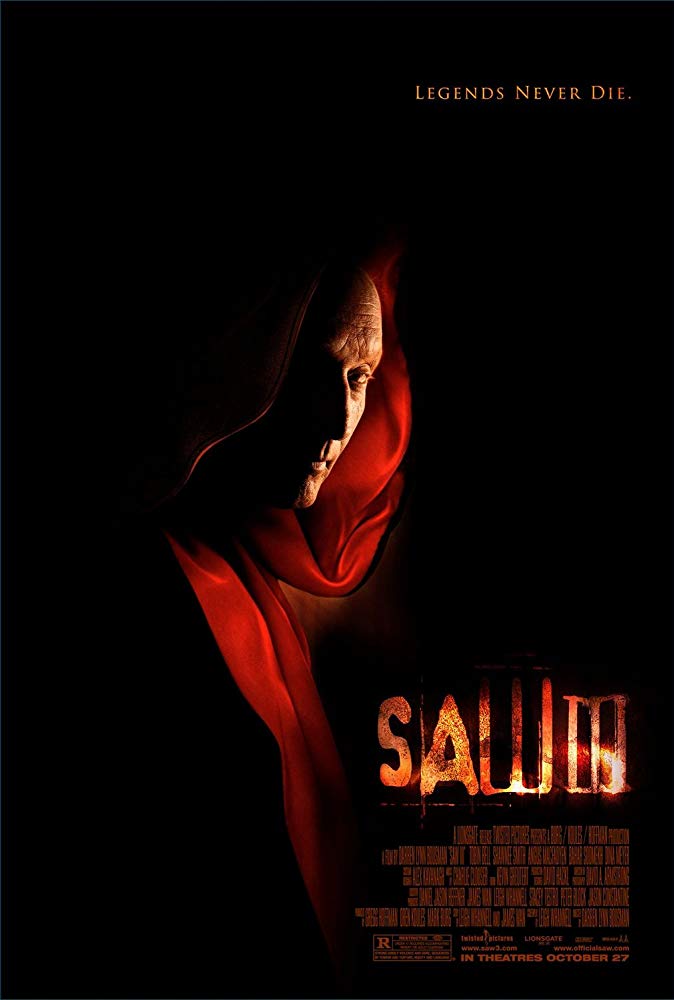
Original SAW writers Leigh Whannell (reprising his SAW role via flashback) and James Wan returned one last time to the franchise for a film clearly devised as the finale of a trilogy, with all key series characters very dead at the end. It achieved the biggest opening of any SAW movie, ensuring the commissioning of SAW IV while this was still in cinemas, and continued the early 2000’s fad for brutal, sadistic horror by unleashing some of the most extreme scenes of protracted gore in a mainstream R-rated American film. It also upholds the nihilistic streak of its predecessors with an appropriately misanthropic final act in which Jigsaw’s attempts to actually save lives are thwarted by human weakness (including man’s natural inclination for retribution) and result in no one getting away unscathed.
By this stage in the series, no one was shying away from the SAW series’ raison d’etre. SAW III’s trailer brazenly emphasised the brutality and suffering, offering a unique shift in genre tradition with its focus on male screams. The opening half-hour of the film delivers a succession of sadistic set pieces in which two returning characters (Donnie Wahlberg and Dina Meyer) are reintroduced only to meet premature, unpleasant ends. Narrowing its focus to a quartet of new characters (unlike the larger ensemble of SAW II), the third chapter also presents more rounded and sympathetic victims than before – notably unhappily married doctor Bahar Soomekh and anguished father Angus Macfadyen, whose life is overwhelmed with the desire for revenge against the drunk driver who killed his son. Their paths intersect with that of Jigsaw – who desperately needs a life-extending operation on his terminal frontal-lobe tumour – and his protegee Amanda, played with a remarkable combination of human vulnerability, psychosis and sexiness by Shawnee Smith.
The longest of the series, this finds time for smaller, creepy moments – including the most sinister use of Jigsaw’s puppet – and continues the admirable focus on narrative continuity with its intricate ties (via carefully integrated flashbacks) to the previous two films. Moreover, it is astonishingly nasty and mean-spirited from start to splattery finish, with stand-out grim highlights including prolonged, graphic power-drill brain surgery, a nod to old-school exploitation involving a frozen naked blonde and the best of the franchise’s medieval-styled traps as a guy’s limbs and cranium are grotesquely twisted via a variation of “The Rack”.
SAW IV *** USA 2007 Dir: Darren Lynn Bousman. 95 mins
The pressure of sustaining a franchise that reached its natural end with SAW III is felt during the over-plotted SAW IV, the third and final sequel directed by Bousman and the first of four consecutive SAW movies written by FEAST’s Patrick Melton and Marcus Dunstan (who later created their own memorable sadistic puppet master with THE COLLECTOR). More than most, this entry will befuddle anyone who hasn’t been paying attention: its narrative hinges on a Big Twist that feels like a composite of the finales of both II and III, and most of the story is happening virtually in tandem with the events of SAW III, which ostensibly means its ending is partially identical to its predecessor! The script is also cluttered by new and old characters (including Angus MacFadyen reprising his III role briefly), and the decision (by necessity) to unveil another participant in Jigsaw’s elaborate games would become the series’ regular test of audience goodwill following Jigsaw’s death.
It opens strong, with the traditional pre-titles unpleasantries and early confirmation that Jigsaw won’t be pulling a Jason Voorhees resurrection-stunt to keep the series going. Following III’s hideous brain surgery sequence, IV begins with a graphic Jigsaw autopsy revelling in close-up brain-removal, the retrieval of a tape secreted in his stomach and, worst of all, a wholly unwelcome glimpse of Jigsaw’s dick. Rocked by the deaths of so many colleagues, SWAT tough guy Lyriq Bent is obsessed with finding Donnie Wahlberg who, at this point in the timeline, has been missing for six months. Instead he becomes the latest pawn in Jigsaw’s games, afforded 90 minutes to rescue Wahlberg and another captured cop – while Bent’s cop pals try to puzzle out who Jigsaw’s other collaborator is, with suspicion falling on his ex-wife (an effective Betsy Russell).
Melton and Dunstan cannily capture the in-house style, misdirecting the audience from the very start, pivoting around a ticking clock deadline, incorporating Tobin Bell’s welcome presence via lengthy flashbacks and, of course, offering a spectacular trap-based death every 10 minutes or so. Fast paced and shot / cut in the same arresting mode as its forebears, it delivers show-stopping gore set pieces, with eyeball-impalings, lathe-scalpings and cranium-dicings. The leap of faith it requires to accept the ultimate reveal was a real test for the fan base, though at this point, the series was still making a fortune.
SAW V ** USA 2008 Dir: David Hackl. 92 mins
Although bookended by two marvellous gore scenes (including a grisly take on “The Pit And The Pendulum”), this series low-point is otherwise disappointingly tame and meandering. More than any other SAW movie, it has the feel of a sequel in which the producers wish they hadn’t killed off the villain in the third movie: top billed Tobin Bell is shoe-horned into extended flashbacks wherever possible, even if the audience doesn’t really need to see a plot arc (the training of Jigsaw apprentice Costas Mandylor) identical to that of the also-deceased Amanda. SAW V, like SAW IV, takes place mostly following the events of SAW III, though the prologue actually occurs before the events of SAW II and at one point we are shown characters preparing a trap featured in the original SAW. We also finally find out the fate of the kid whose life was left in the balance at the end of SAW III. The attention to detail and continuity is again impressive, but this time out, at the expense of anything new or compelling.
Fresh from his pseudo-Jigsaw work in IV, Mandylor escapes the building in which almost everything crucial has happened since the beginning of III, while Agent Scott Patterson – who narrowly escaped one of Hoffman’s traps via an unlikely D.I.Y. tracheotomy – spends the whole film v-e-r-y slowly trying to prove his guilt. We also watch the final collaboration between Jigsaw and Mandylor unfold: five unsympathetic, interconnected bastards are set an all-too-familiar series of challenges and traps (one of them is played by BUFFY / DEXTER star Julie Benz in a bad wig).
Poor decisions are perhaps inevitable when you’re facing a yearly Halloween weekend deadline for each SAW sequel. Did no one flag up the mistake of casting two leading men who, boasting the same basic haircut, look very similar in the series’ murky lighting conditions? Although Mandylor isn’t bad as Jigsaw’s latest apprentice, Patterson is laughably wooden as the Basil Exposition of the SAW films – a character with no charisma who talks to himself a lot and exists as a walking plot device to transport us to the now-expected final twist. This inert stop-gap in the series resembles one of those TV shows in which a season-overspend results in a whole episode where the heroes recall past experiences as a means of framing a bunch of money-saving old clips.
SAW VI **** USA 2009 Dir: Kevin Greutert. 90 mins
The first SAW sequel to not meet its box-office expectations, the sixth entry is still, narratively speaking, a closed-door for anyone with no fore-knowledge of the earlier films, but its relative failure was less due to its actual quality and more a result of being overshadowed by the runaway success of PARANORMAL ACTIVITY, and the bad will generated by the stalemate of SAW V. The directing debut of Kevin Greutert (who edited the first five SAW films and JIGSAW), this amps up the pace, offers a clever, timely set-up and gives closure to dangling plot threads that parts 4 and 5 were content to dance around. It is still somewhat compromised by the need to incorporate Tobin Bell’s Jigsaw to a strong enough degree to allow him top-billing, and also brings back Amanda (Shawnee Smith) for new footage but, on this occasion, screenwriters Melton and Dunstan’s astute attention to continuity pays off effectively.
It opens strong, with a topical, blackly humorous prologue involving irresponsible lenders (!) trapped in the most intensely sadistic SAW opening since SAW III, striving to save their own lives by competing to see who can hack off the most flesh in 60 seconds. Any Hollywood movie that begins with an obese bloke slashing chunks from his own fat belly while a young woman hacks off her own arm to beat him deserves plaudits of some kind. Subsequently, Jigsaw successor Costas Mandylor, having framed SAW V’s doomed cop hero, resumes more of his master’s post-mortem wishes – forcing Jigsaw’s unscrupulous health insurance broker to jump through a series of increasingly horrific hoops to stay alive. Police chief Mark Rolston, back from SAW V, doesn’t catch on (until it’s too late) that the twitchy-acting Mandylor is responsible, while Jigsaw’s widow (Betsy Russell, with more to do this time out) clarifies her relevance in the story arc, via the best SAW twist since SAW III, providing a pleasing sense of full-circle closure.
The core plot-line of terrified broker Peter Outerbridge (in a terrific performance) facing a series of grim challenges provides a lot of genuine tension, with a stand-out carousel sequence in which he has to select two co-workers to survive from a group of six – all of whom make up the team employed to seek out clauses in clients’ insurance policies that enable their company to avoid paying out. There’s also a bravura hydrochloric acid demise, and a splendid sense of relevance for a post-credit-crunch world yearning to see duplicitous financial services employees suffering at length.
SAW 3D (a.k.a. Saw 3D: The Final Chapter) **** USA 2010 Dir: Kevin Greutert. 91 mins
Although no one believed the film’s “Final Chapter” subtitle anymore than they believed it when FRIDAY THE 13TH used the same, the seventh SAW certainly acts like a go-for-broke series finale. Stripping away the gratuitous flashbacks of previous instalments (top-billed as ever, Tobin Bell only physically appears in a single, short scene and is otherwise represented by that distinctive voice), it wittily brings things full-circle, tying up loose ends and winding up exactly where the 2004 original began and ended. Cary Elwes returns to the series, still scarred from surviving Jigsaw’s games, and attending “survivor” meetings overseen by a guy who has manufactured his own gruesome backstory to win fame, fortune and a trophy wife. After his latest TV chat show appearance, he is placed in an extended game centered around the potential rescue of his wife; he has 90 minutes to save her via a series of traps involving other abducted parties; meanwhile Hoffman (Costas Madylor), whose character arc was exhausted by SAW VI, sews up his face and plots revenge against the ex-Mrs Jigsaw (Betsy Russell).
For the big “finale”, Dunstan and Melton emphasise elaborate, uber-bloody death set pieces. Seven years earlier, Lionsgate had to tone down the virtually gore-free SAW for an R rating; with SAW 3-D, we can only assume the MPAA had simply given up. At this point in the franchise, it was inevitable that it would also be self-aware: the opening finally breaks out of the series’ tradition of dingy warehouses, dirty bathrooms and abandoned factories, for a trap set in the glaring light of day, in a shopping mall window display. A crowd gathers to watch the unfolding torment of a young woman as she is bisected by a huge table saw above her two screaming lovers. One bystander calls the cops, but most are content, like we the SAW fans, to not look away or recoil in horror – but to watch with pleasure, some capturing the intestine spillage on cell phone cameras.
The film relishes the chance for 3-D wall-to-wall viscera as much as the third FRIDAY THE 13TH movie: shattering glass, spikes, splattering flesh, blood and brains are hurled at the audience. It’s the kind of movie that gives Betsy Russell an elaborate body-ripping dream sequence death, just to shoehorn in extra gore before she eventually loses face (spectacularly) in a reworking of the original film’s bear trap device. Elsewhere, the late Chester Bennington has to unglue himself from a car seat in the most painful way possible, while the nearest person we have to a “hero” removes his teeth with pliers, is trussed up a la A MAN CALLED HORSE and watches his wife getting cooked in a oven. Anyone paying close attention to some of the acting or, indeed, the outrageous plot contrivances, would find plenty to carp about, and the twists, reveals and set-ups will be highly familiar to even the causal SAW fan. But none of this matters for a movie that turns out to be the most gleefully nasty, visually inventive and dynamically paced of the whole run.
JIGSAW **** USA 2017 Dir: Michael Spierig, Peter Spierig. 92 mins 18 (R)
Seven years after THE FINAL CHAPTER, Lionsgate dusted off the franchise, employing the talented Spierig brothers (UNDEAD, DAYBREAKERS) to fashion a new, twisting series of sadistic games – though this briskly paced, hugely enjoyable revival downplays the more brutal gore gags of the earlier films, and largely shuns the grungy, decayed visual aesthetic and frenetic editing styles the series previously specialised in. Opening with a frenetic car chase and confrontation, the Spierigs opt for a more action-driven approach and craft a compelling narrative that flits between Callum Keith Rennie’s investigation of a series of Jigsaw-like murders (ten years after his death in SAW III) and a depleting group of strangers in a trap-laden farmhouse who are forced to face their past sins and shed blood to stay alive.
Refreshingly, this has a lighter touch than the mostly humourless earlier films: “She seems to get off on this sick shit!” someone notes of sexy, shifty coroner / Jigsaw trap collector Hannah Emily Anderson at one point. The new characters are stronger than most, with Matt Passmore finding hidden depths as the buff, Afghan-veteran hero, and the movie unfolds, like most horror sequels in which the villain is apparently dead, as a whodunnit, unfolding in a world where everyone knows who Jigsaw is and anyone could be a psychotic copycat. The Spierigs have fun with the expected array of gruesomeness: autopsies, acid injections and a bravura sequence in which characters have a succession of sharp objects dropped on them. The more medieval traps and devices of the earlier films are updated to incorporate lasers, and the emphasis is on knockabout gory spectacle rather than cringe-inducing mutilations.
Echoing its predecessors, JIGSAW unleashes outrageous plot contrivances, climactic montages, a warped time frame and a sliding-door punchline, and does so with élan and a dynamic pace. If there’s nothing new on offer, that’s forgivable for the eight chapter in any series. And, if the ultimate twist is guessable for those who have followed the franchise to date, there is still substantial pleasure in being reminded why Tobin Bell’s character is such an iconic presence and why we lapped up these things every Halloween in the first place.
Reviews by Steven West

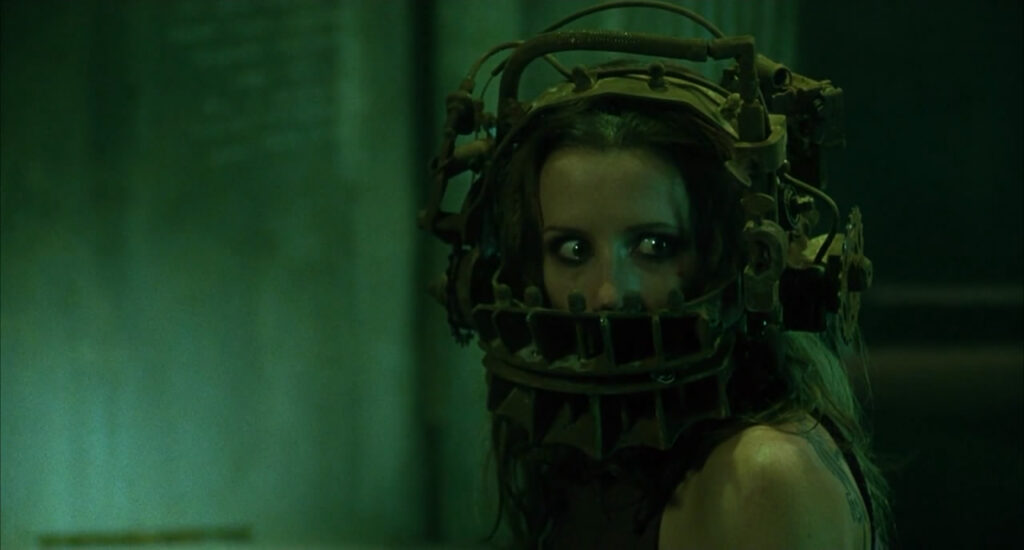
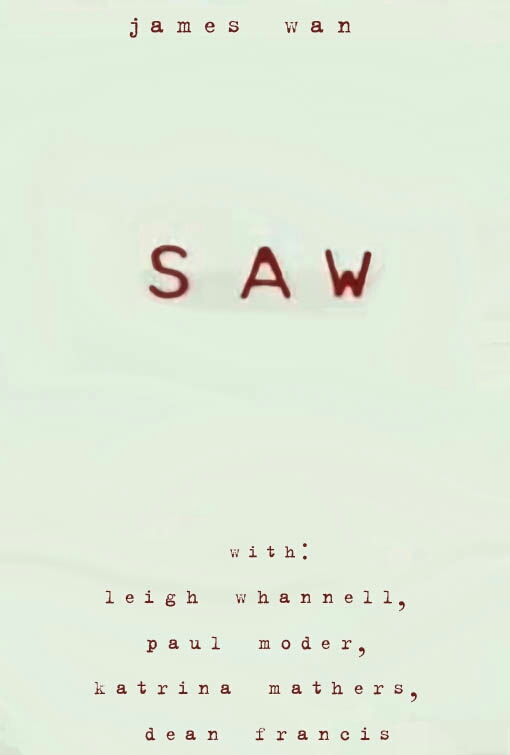
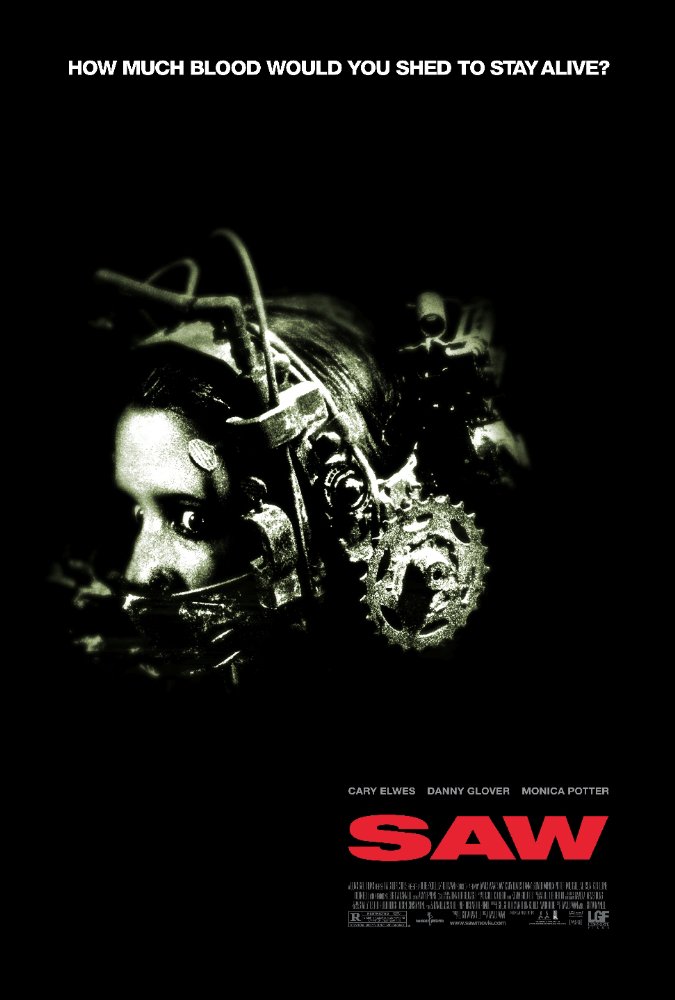
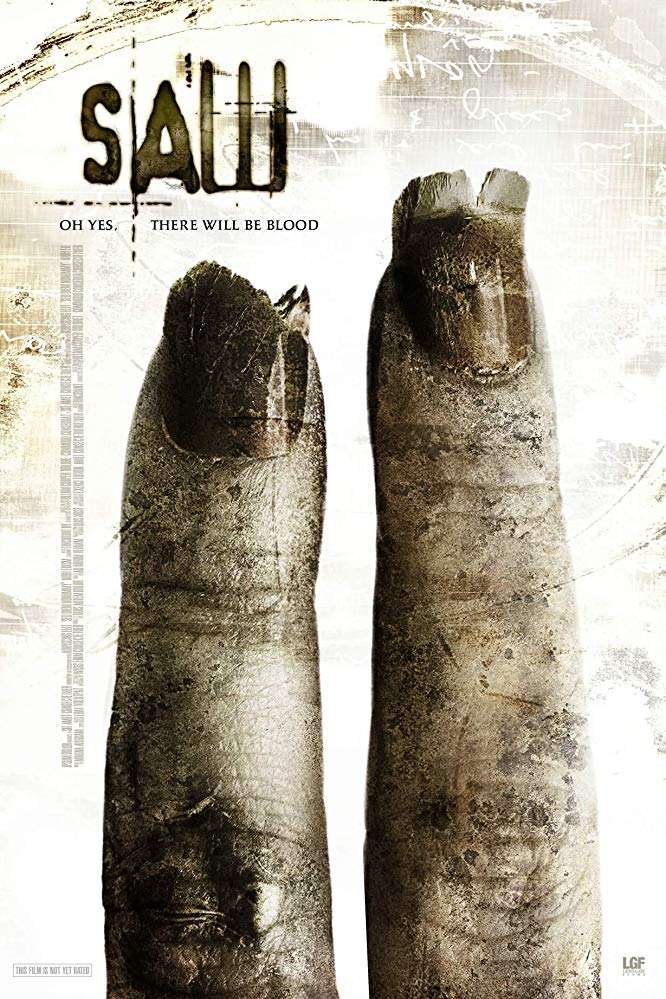
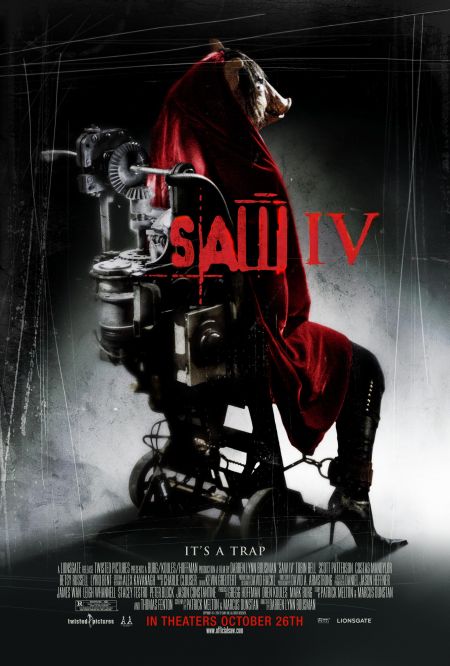

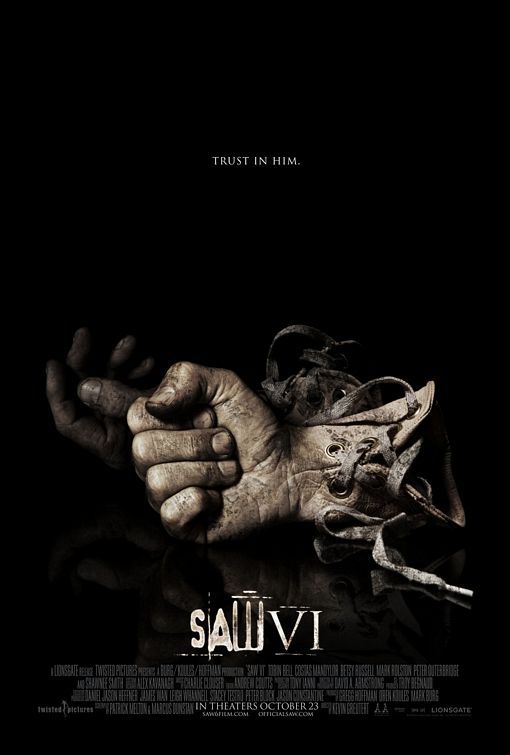
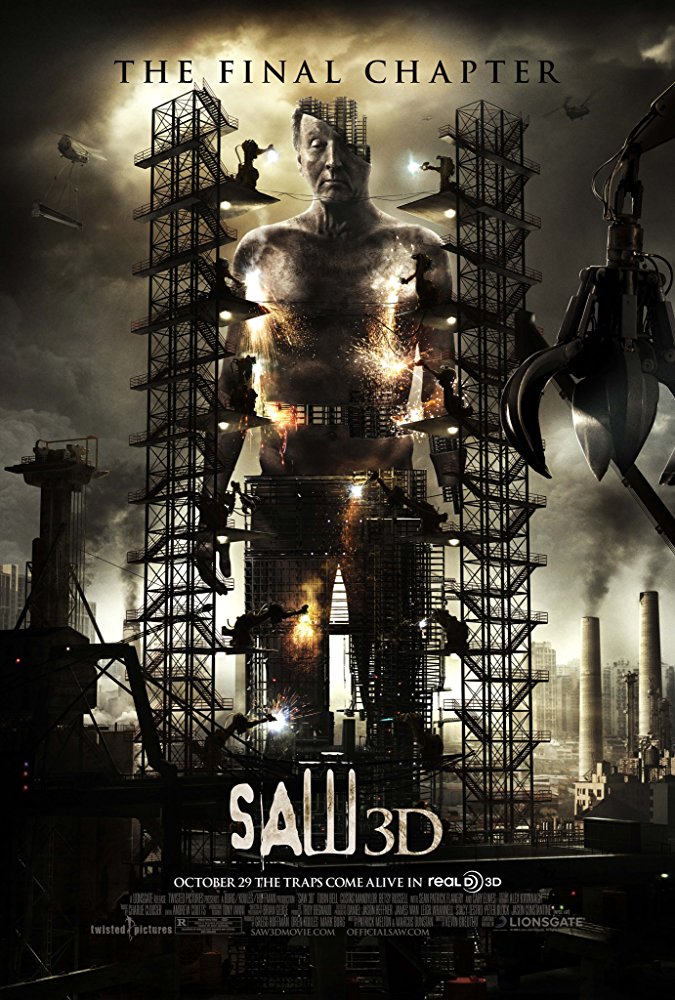
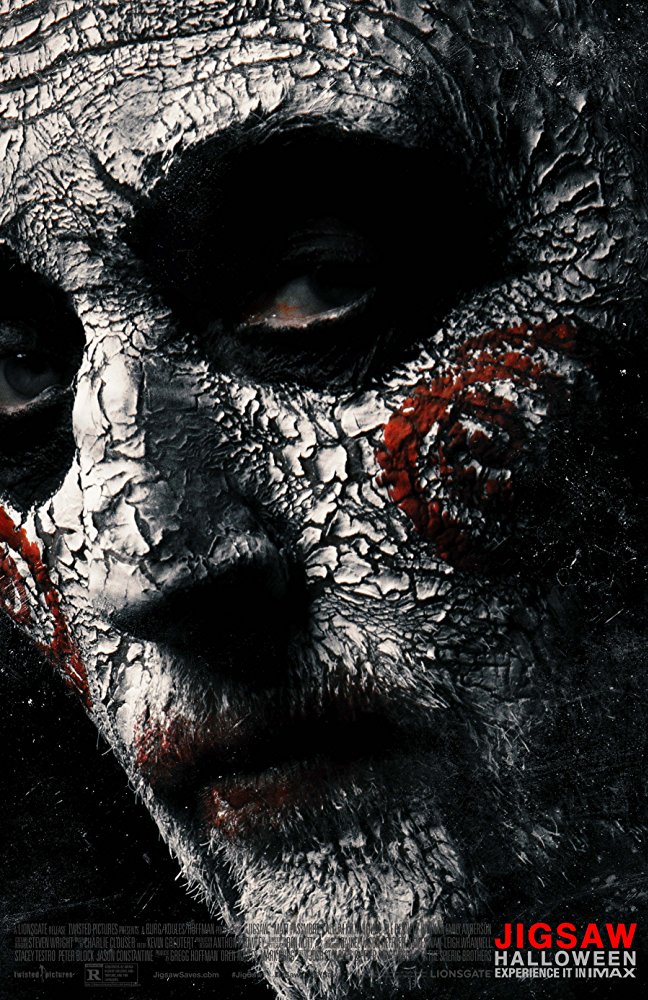
1 Comment
Pingback: UK DISTRIBUTORS FOUND FOR HORROR THRILLER ‘ALIVE’